Training People to Think in Opposites Facilitates the Falsification Process in Wason’s Rule Discovery Task
Abstract
1. Introduction
1.1. Some Ways to Facilitate the 2-4-6 Task
1.2. Rationale for Testing the Effects of Training Reasoners to “Think in Opposites”
2. The Study
2.1. Method
2.1.1. Participants
2.1.2. Procedure
“This strategy can be used to generate the test triples that will help you to discover the rule for Wason’s problem. To explain the strategy, I will refer to triples made up of shapes, but in the task, numbers are used.Below is a triple set of shapes that conforms to the rule I have in mind. Look carefully at the three shapes and think about the properties they have in common.For instance:
- -
- -
- -
- -
- -
- -
- -
2.1.3. Materials
2.1.4. Data Analyses
3. Results
4. Final Discussion
Author Contributions
Funding
Institutional Review Board Statement
Informed Consent Statement
Data Availability Statement
Acknowledgments
Conflicts of Interest
References
- Ackerman, Rakefet, and Valerie A. Thompson. 2018. Meta-reasoning: Shedding metacognitive light on reasoning research. In The Routledge International Handbook of Thinking and Reasoning. Edited by Linden J. Ball and Valerie A. Thompson. London: Routledge/Taylor & Francis Group, pp. 1–15. [Google Scholar]
- Augustinova, Maria. 2008. Falsification cueing in collective reasoning: Example of the wason selection task. European Journal of Social Psychology 38: 770–85. [Google Scholar] [CrossRef]
- Bates, Duglas, Martin Maechler, Ben Bolker, and Steve Walker. 2015. Fitting linear mixed-effects models using lme4. Journal of Statistical Software 67: 1–48. [Google Scholar] [CrossRef]
- Beck, Sarah R., Elizabeth J. Robinson, Daniel J. Carroll, and Ian A. Apperly. 2006. Children’s thinking about counterfactuals and future hypotheticals as possibilities. Child Development 77: 413–26. [Google Scholar] [CrossRef] [PubMed]
- Bianchi, Ivana, and Erika Branchini. 2023. Does Thinking in Opposites in Order to Think Differently Improve Creativity? Journal of Intelligence 11: 85. [Google Scholar] [CrossRef]
- Bianchi, Ivana, and Ugo Savardi. 2008a. The Perception of Contraries. Rome: Aracne. [Google Scholar]
- Bianchi, Ivana, and Ugo Savardi. 2008b. The relationship perceived between the real body and the mirror image. Perception 5: 666–87. [Google Scholar] [CrossRef]
- Bianchi, Ivana, and Ugo Savardi. 2018. Spatial contraries and mirrors. In Spatial Biases in Perception and Cognition. Edited by Timothy L. Hubbard. Cambridge: Cambridge University Press, pp. 209–21. [Google Scholar]
- Bianchi, Ivana, Carita Paradis, Roberto Burro, Joost van de Weijer, Marcus Nyström, and Ugo Savardi. 2017a. Identification of opposites and intermediates by eye and by hand. Acta Psychologica 180: 175–89. [Google Scholar] [CrossRef]
- Bianchi, Ivana, Erika Branchini, Roberto Burro, Elena Capitani, and Ugo Savardi. 2020. Overtly prompting people to “think in opposites” supports insight problem solving. Thinking and Reasoning 26: 31–67. [Google Scholar] [CrossRef]
- Bianchi, Ivana, Marco Bertamini, Roberto Burro, and Ugo Savardi. 2017b. Opposition and Identicalness: Two Basic Components of Adults’ Perception and Mental Representation of Symmetry. Symmetry 9: 128. [Google Scholar] [CrossRef]
- Bianchi, Ivana, Roberto Burro, Roberta Pezzola, and Ugo Savardi. 2017c. Matching Visual and Acoustic Mirror Forms. Symmetry 9: 39. [Google Scholar] [CrossRef]
- Bianchi, Ivana, Roberto Burro, Stefania Torquati, and Ugo Savardi. 2013. The middle of the road. Acta Psychologica 144: 121–35. [Google Scholar] [CrossRef]
- Bianchi, Ivana, Ugo Savardi, and Michael Kubovy. 2011a. Dimensions and their poles: A metric and topological theory of opposites. Language and Cognitive Processes 26: 1232–65. [Google Scholar] [CrossRef]
- Bianchi, Ivana, Ugo Savardi, Roberto Burro, and Maria Francesca Martelli. 2014. Doing the opposite to what another person is doing. Acta Psychologica 151: 117–33. [Google Scholar] [CrossRef]
- Bianchi, Ivana, Ugo Savardi, Roberto Burro, and Stefania Torquati. 2011b. Negation and psychological dimensions. Journal of Cognitive Psychology 23: 275–301. [Google Scholar] [CrossRef]
- Branchini, Erika, Elena Capitani, Roberto Burro, Ugo Savardi, and Ivana Bianchi. 2021. Opposites in reasoning processes: Do we use them more than we think, but less than we could? Frontiers in Psychology 12: 715696. [Google Scholar] [CrossRef]
- Branchini, Erika, Ivana Bianchi, Roberto Burro, Elena Capitani, and Ugo Savardi. 2016. Can contraries prompt intuition in insight problem solving? Frontiers in Psychology 7: 1962. [Google Scholar] [CrossRef] [PubMed]
- Branchini, Erika, Roberto Burro, Ivana Bianchi, and Ugo Savardi. 2015a. Contraries as an effective strategy in geometrical problem solving. Thinking and Reasoning 21: 397–430. [Google Scholar] [CrossRef]
- Branchini, Erika, Ugo Savardi, and Ivana Bianchi. 2015b. Productive thinking: The role of perception and perceiving opposition. Gestalt Theory 37: 7–24. [Google Scholar]
- Byrne, Ruth M. J. 2016. Counterfactual Thought. Annual Review of Psychology 67: 135–57. [Google Scholar] [CrossRef]
- Byrne, Ruth M. J. 2018. Counterfactual reasoning and Imagination. In The Routledge Handbook of Thinking and Reasoning. Edited by Linden J. Ball and Valerie A. Thompson. London: Routledge, pp. 71–87. [Google Scholar]
- Byrne, Ruth M. J., and Alice McEleney. 2000. Counterfactual thinking about actions and failures to act. Journal of Experimental Psychology: Learning, Memory and Cognition 26: 1318–31. [Google Scholar] [CrossRef]
- Casasola, Marinella, Leslie B. Cohen, and Elizabeth Chiarello. 2003. Six-month-old infants’ categorization of containment spatial relations. Child Development 74: 1–15. [Google Scholar] [CrossRef]
- Casasola, Marinella. 2008. The Development of Infants’ Spatial Categories. Current Direction in Psychological Science 7: 21–25. [Google Scholar] [CrossRef]
- Cherubini, Paolo, Elena Castelvecchio, and Anna Maria Cherubini. 2005. Generation of hypotheses in Wason’s 2-4-6 task: An information theory approach. The Quarterly Journal of Experimental Psychology 58A: 309–32. [Google Scholar] [CrossRef] [PubMed]
- Cooper, Binyamin, Cristopher R. Giordano, Amir Erez, Trevor A. Foulk, Heather Reed, and Kent B. Berg. 2022. Trapped by a first hypothesis: How rudeness leads to anchoring. Journal of Applied Psychology 107: 481–502. [Google Scholar] [CrossRef] [PubMed]
- Evans, Johnathan St. B. T. 2016. Reasoning, biases and dual processes: The lasting impact of Wason (1960). The Quarterly Journal of Experimental Psychology 69: 2076–92. [Google Scholar] [CrossRef]
- Farris, Hilary, and Russell Revlin. 1989a. The discovery process: A counterfactual strategy. Social Studies of Science 19: 497–513. [Google Scholar] [CrossRef]
- Farris, Hilary, and Russell Revlin. 1989b. Sensible reasoning in two tasks: Rule discovery and hypothesis evaluation. Memory & Cognition 17: 221–32. [Google Scholar]
- Fitzgibbon, Lily, Henrike Moll, Julia Carboni, Ryan Lee, and Morteza Dehghani. 2019. Counterfactual curiosity in preschool children. Journal of Experimental Child Psychology 183: 146–57. [Google Scholar] [CrossRef]
- Gale, Maggie, and Linden J. Ball. 2006. Dual-goal facilitation in Wason’s 2-4-6 task: What mediates successful rule discovery? The Quarterly Journal of Experimental Psychology 59: 873–85. [Google Scholar] [CrossRef]
- Gale, Maggie, and Linden J. Ball. 2009. Exploring the determinants of dual goal facilitation in a rule discovery task. Thinking and Reasoning 15: 294–315. [Google Scholar] [CrossRef]
- Gale, Maggie, and Linden J. Ball. 2012. Contrast class cue and performance falicitation in hypothesis-testing taks: Evidence for an iterative counterfactual model. Memory & Cognition 40: 408–19. [Google Scholar]
- Gärdenfors, Peter. 2000. Conceptual Spaces: The Geometry of Thought. Cambridge: The MIT Press. [Google Scholar]
- Gärdenfors, Peter. 2014. The Geometry of Meaning: Semantics Based on Conceptual Spaces. Cambridge: The MIT Press. [Google Scholar]
- Girotto, Vittorio, and Michel Gonzalez. 2000. Strategies and models in statistical reasoning. In Deductive Reasoning and Strategies. Edited by Walter Schaeken, Gino De Vooght, André Vandierendonck and Géry d’Ydewalle. Mahwah: Lawrence Erlbaum Associates, pp. 267–85. [Google Scholar]
- Gorman, Michael E., and Margaret E. Gorman. 1984. A comparison of disconfirmatory, confirmatory and a control strategy on Wason’s 2-4-6 task. The Quarterly Journal of Experimental Psychology 36A: 629–48. [Google Scholar] [CrossRef]
- Gorman, Michael E., Ann Stafford, and Margaret E. Gorman. 1987. Disconfirmation and dual hypotheses on a more difficult version of Wason’s 2-4-6 task. The Quarterly Journal of Experimental Psychology 39A: 1–28. [Google Scholar] [CrossRef]
- Gorman, Michael E., Margaret E. Gorman, R. Michael Latta, and Guy Cunningham. 1984. How disconfirmatory, confirmatory and combined strategies affect group problem solving. British Journal of Psychology 75: 65–74. [Google Scholar] [CrossRef]
- Hegarty, Peter. 2017. On the failure to notice that white people are white: Generating and testing hypotheses in the celebrity guessing game. Journal of Experimental Psychology: General 146: 41–62. [Google Scholar] [CrossRef]
- Jones, Steven. 2002. Antonymy: A Corpus-Based Study. London and New York: Routledge. [Google Scholar]
- Jones, Steven. 2007. ‘Opposites’ in discourse: A comparison of antonym use across four domains. Journal of Pragmatics 39: 1105–19. [Google Scholar] [CrossRef]
- Kaup, Barbara, Jana Lüdtke, and Rolf Zwaan. 2006. Processing negated sentences with contradictory predicates: Is a door that is not open mentally closed? Journal of Pragmatics 38: 1033–50. [Google Scholar] [CrossRef]
- Kaup, Barbara, Richard H. Yaxley, Carol J. Madden, Rolf A. Zwaan, and Jana Lüdtke. 2007. Experiential simulations of negated text information. Quarterly Journal of Experimental Psychology 60: 976–90. [Google Scholar] [CrossRef] [PubMed]
- Mayo, Ruth, Dana Alfasi, and Norbert Schwarz. 2014. Distrust and positive test heuristics: Dispositional and situated social distrust improves perfomance on the Wason rule discovery task. Journal of Experimental Psychology: General 143: 985–90. [Google Scholar] [CrossRef]
- Meyer, David, Achim Zeileis, and Kurt Hornik. 2006. The strucplot framework: Visualizing multi-way contingency tables with vcd. Journal of Statistical Software 17: 1–48. [Google Scholar] [CrossRef]
- Oaksford, Mike. 2002. Contrast classes and matching bias as explanations of the effects of negation on conditional reasoning. Thinking and Reasoning 8: 135–51. [Google Scholar] [CrossRef]
- Oaksford, Mike, and Keith Stenning. 1992. Reasoning with conditionals containing negated constituents. Journal of Experimental Psychology: Learning, Memory, and Cognition 18: 835–54. [Google Scholar] [CrossRef] [PubMed]
- Oaksford, Mike, and Nick Chater. 1994a. Another look at eliminative and enumerative behaviour in a conceptual task. European Journal of Cognitive Psychology 6: 149–69. [Google Scholar] [CrossRef]
- Oaksford, Mike, and Nick Chater. 1994b. A rational analysis of the selection task as optimal data selection. Psychological Review 101: 608–31. [Google Scholar] [CrossRef]
- Öllinger, Michael, Gary Jones, Amory H. Faber, and Günther Knoblich. 2013. Cognitive mechanisms of insight: The role of heuristics and representational change in solving the eight-coin problem. Journal of Experimental Psychology: Learning, Memory, and Cognition 39: 931–39. [Google Scholar] [CrossRef] [PubMed]
- Paradis, Carita, and Caroline Willners. 2006. Antonymy and negation. The boundedness hypothesis. Journal of Pragmatics 38: 1051–80. [Google Scholar] [CrossRef]
- Paradis, Carita, Caroline Willners, and Steven Jones. 2009. Good and bad opposites: Using textual and experimental techniques to measure antonym canonicity. The Mental Lexicon 4: 380–429. [Google Scholar] [CrossRef]
- R Core Team. 2023. R: A Language and Environment for Statistical Computing. Vienna: R Foundation for Statistical Computing. Available online: https://www.R-project.org/ (accessed on 15 March 2023).
- Rafetseder, Eva, Renate Renate Cristi-Vargas, and Josef Perner. 2010. Counterfactual reasoning: Developing a sense of “nearest possible world”. Child Development 81: 376–89. [Google Scholar] [CrossRef]
- Ragni, Marco, Ilir Kola, and Philip N. Johnson-Laird. 2018. On selecting evidence to test hypothesis: A theory of selection task. Psychological Bulletin 144: 779–86. [Google Scholar] [CrossRef]
- Rossi, Sandrine, Jean Paul Caverni, and Vittorio Girotto. 2001. Hypotesis testing in a rule discovery problem: When a focused procedure is effective. The Quarterly Journal of Experimental Psychology 54A: 263–67. [Google Scholar] [CrossRef]
- Rusconi, Patrice, Simona Sacchi, Armando Toscano, and Paolo Cherubini. 2012. Confirming expectations in asymmetric and symmetric social hypothesis testing. Experimental Psychology 59: 243–50. [Google Scholar] [CrossRef]
- Sauerland, Melanie, Henri Otgaar, Enide Maegherman, and Anna Sagana. 2020. Allegiance bias in statement reliability evaluations is not eliminated by falsification instructions. Zeitschrift für Psychologie 228: 210–15. [Google Scholar] [CrossRef]
- Schroyens, Walter J., Walter Schaeken, and Géry d’Ydewalle. 2001. The processing of negations in conditional reasoning: A meta-analytic case study in mental model and/or mental logic theory. Thinking and Reasoning 7: 121–72. [Google Scholar] [CrossRef]
- Schroyens, Walter, Niki Verschueren, Walter Schaeken, and Gery D’Ydewalle. 2000. Conditional reasoning with negations: Implicit and explicit affirmation or denial and the role of contrast classes. Thinking & Reasoning 6: 221–51. [Google Scholar]
- Thompson, Valerie A. 2009. Dual-process theories: A metacognitive perspective. In Two Minds: Dual Processes and Beyond. Edited by Johnathan St. B. T. Evans and Keith Frankish. New York: Oxford University Press, pp. 171–95. [Google Scholar]
- Thompson, Valerie A., and Stephen C. Johnson. 2014. Conflict, metacognition, and analytic thinking. Thinking and Reasoning 20: 215–44. [Google Scholar] [CrossRef]
- Thompson, Valerie A., Jonathan St. B. T. Evans, and Jamie I. D. Campbell. 2013. Matching bias on the selection task: It’s fast and feels good. Thinking &Reasoning 19: 431–52. [Google Scholar]
- Thompson, Valerie A., Stephen E. Newstead, and Nicola J. Morley. 2011. Methodological and theoretical issues in belief bias. In The Science of Reason: A Festschrift for Jonathan St. B. T. Evans. Edited by Ken I. Manktelow, David E. Over and Shira Elqayam. London: Psychology Press, pp. 309–38. [Google Scholar]
- Tschirgi, Judith E. 1980. Sensible reasoning: A hypothesis about hypotheses. Child Development 51: 1–10. [Google Scholar] [CrossRef]
- Tukey, David D. 1986. A philosophical and empirical analysis of subjects’ modes of inquiry in Wason’s 2-4-6 task. The Quarterly Journal of Experimental Psychology 38A: 5–33. [Google Scholar] [CrossRef]
- Tweney, Ryan D., Michael E. Doherty, Winifred J. Worner, Daniel B. Pliske, Clifford R. Mynatt, Kimberly A. Gross, and Daniel L. Arkkelin. 1980. Strategies of rule discovery in an inference task. The Quarterly Journal of Experimental Psychology 32: 109–23. [Google Scholar] [CrossRef]
- Vallée-Tourangeau, Frédérick, Neville G. Austin, and Sandra Rankin. 1995. Inducing a rule in Wason’s 2-4-6 task: A test of the information-quantity and goal-complementarity hypotheses. The Quarterly Journal of Experimental Psychology A: Human Experimental Psychology 48A: 895–914. [Google Scholar]
- Vance, James, and Mike Oaksford. 2021. Explaining the implicit negations effect in conditional inference: Experience, probabilities, and contrast sets. Journal of Experimental Psychology: General 150: 354–84. [Google Scholar] [CrossRef]
- Wason, Peter C. 1960. On the failure to eliminate hypotheses in a conceptual task. Quarterly Journal of Experimental Psychology 12: 129–40. [Google Scholar] [CrossRef]
- Wharton, Charles M., Patricia W. Cheng, and Thomas D. Wickens. 1993. Hypothesis testing strategies: Why two goals are better than one. The Quarterly Journal of Experimental Psychology 46A: 743–58. [Google Scholar] [CrossRef]
- World Medical Association. 2013. World Medical Association Declaration of Helsinki: Ethical principles for medical research involving human subjects. JAMA 310: 2191–94. [Google Scholar] [CrossRef] [PubMed]
- Zhang, Zhiyong, and Yang Mai. 2022. WebPower: Basic and Advanced Statistical Power Analysis. R Package Version 0.9.2. Available online: https://CRAN.R-project.org/package=WebPower (accessed on 10 March 2023).
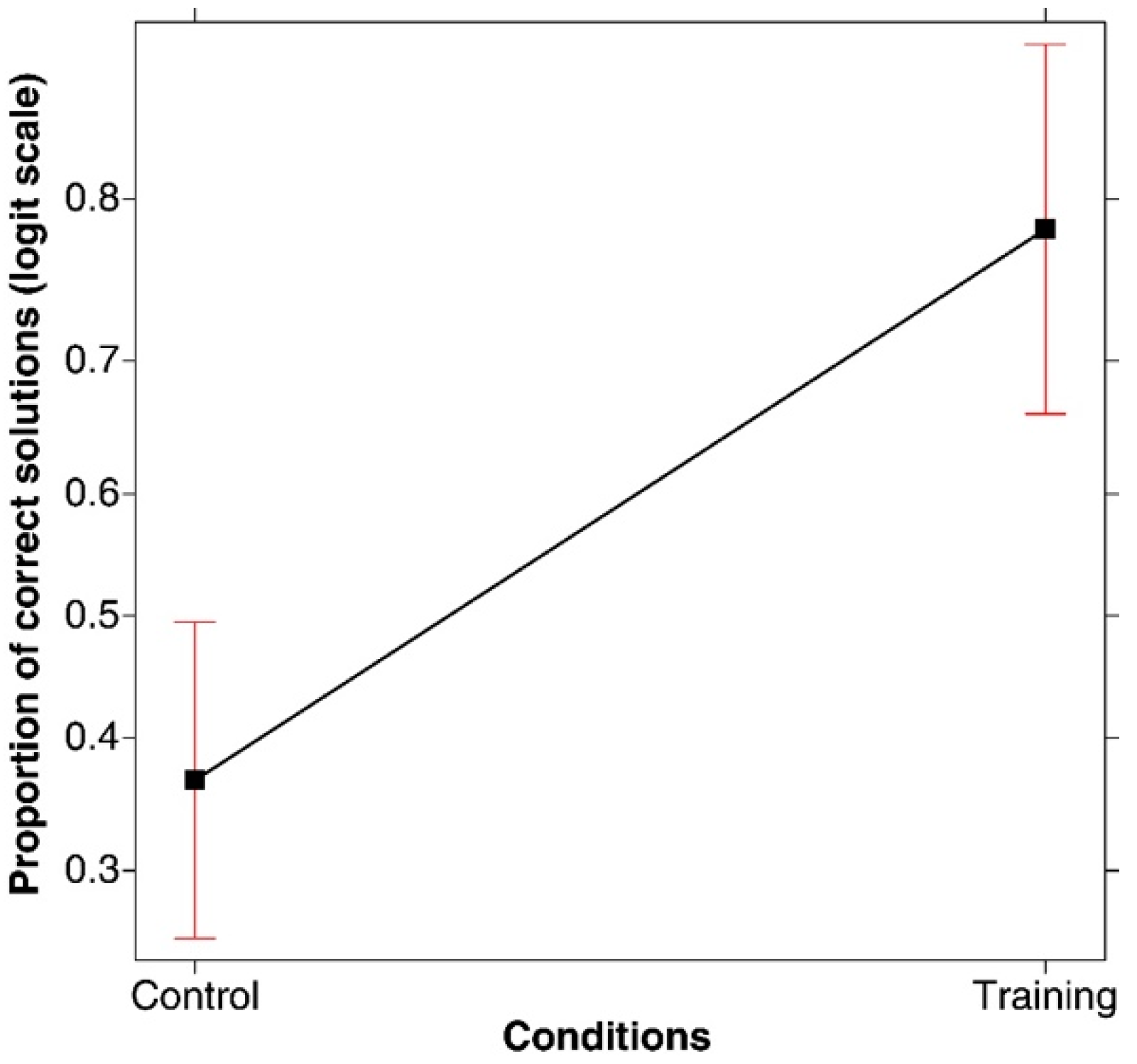
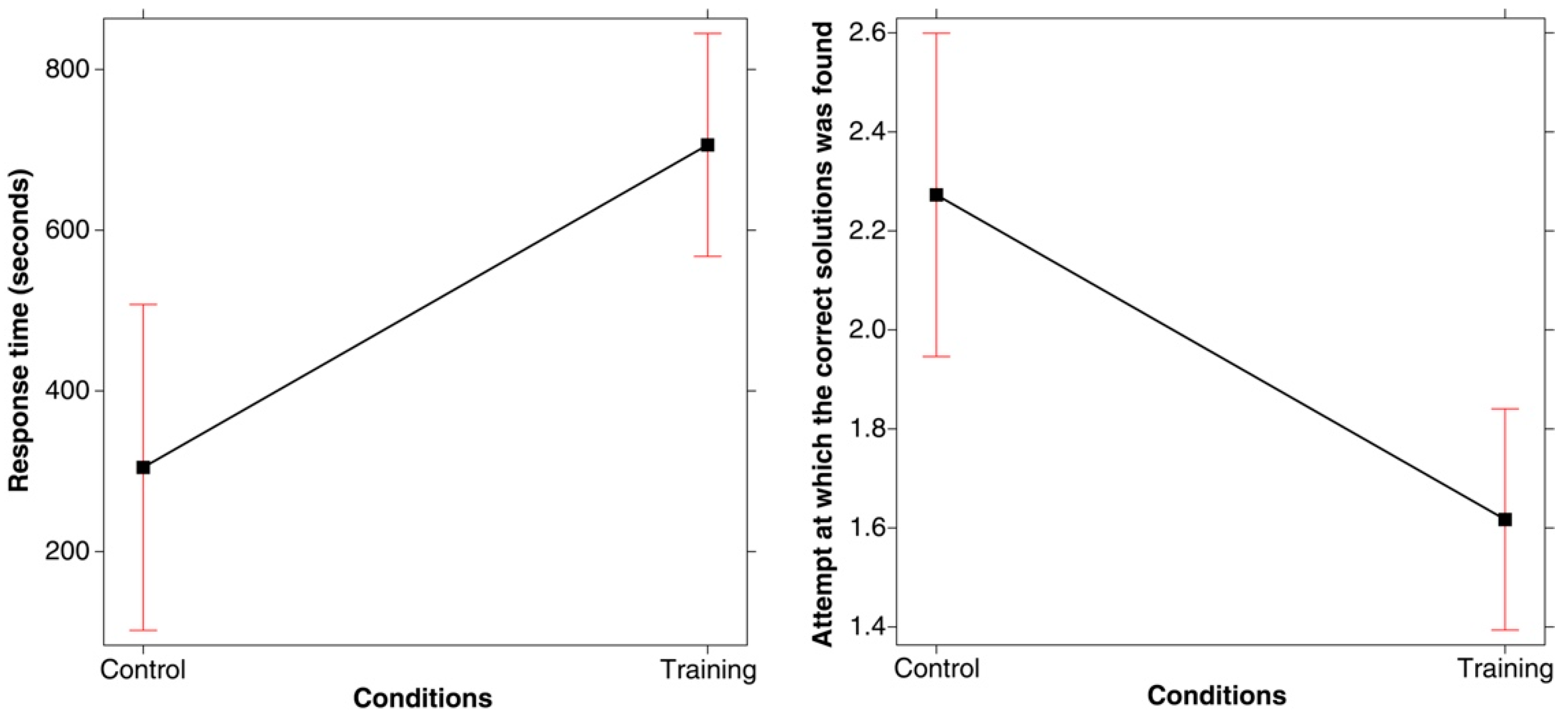
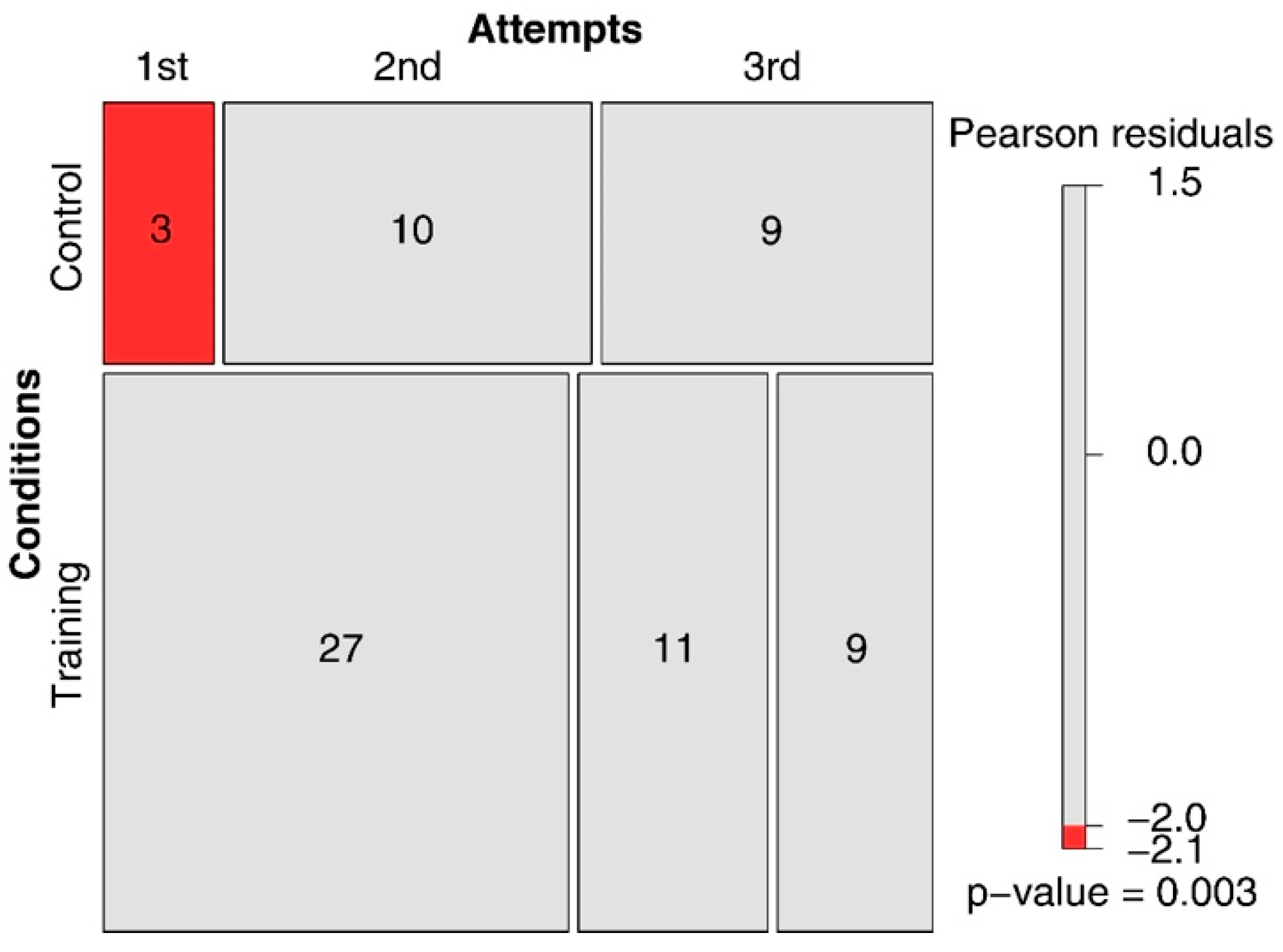
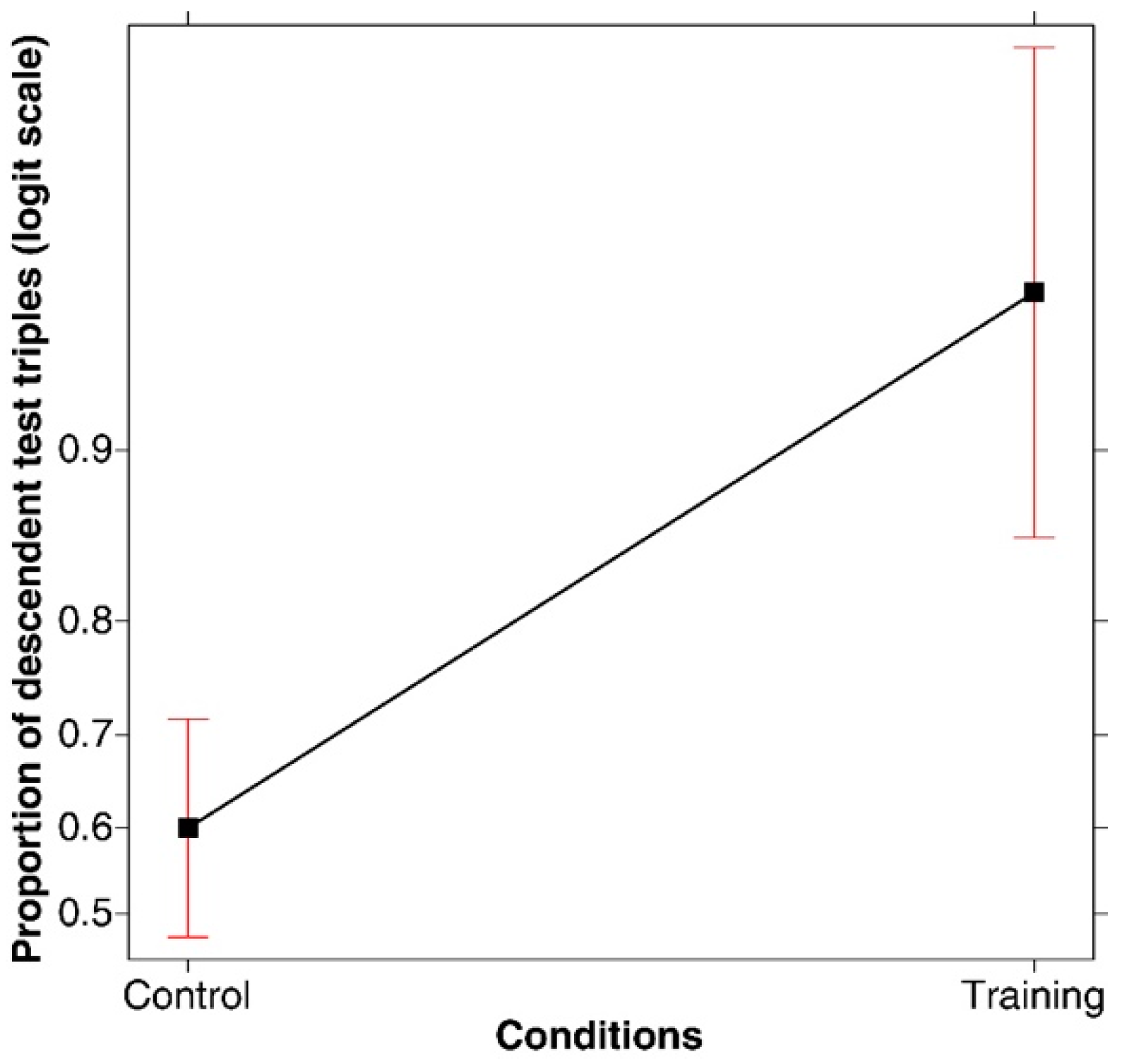

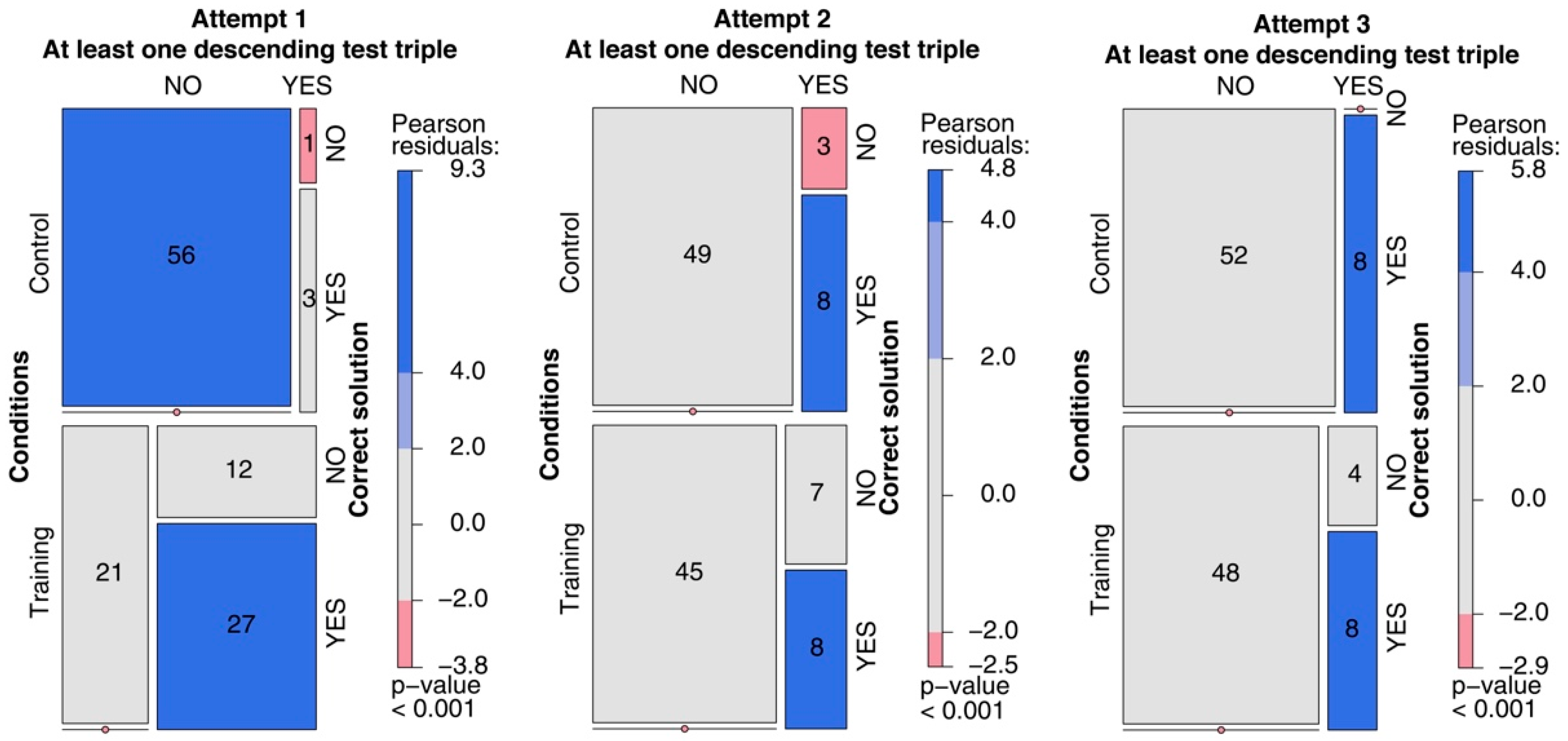
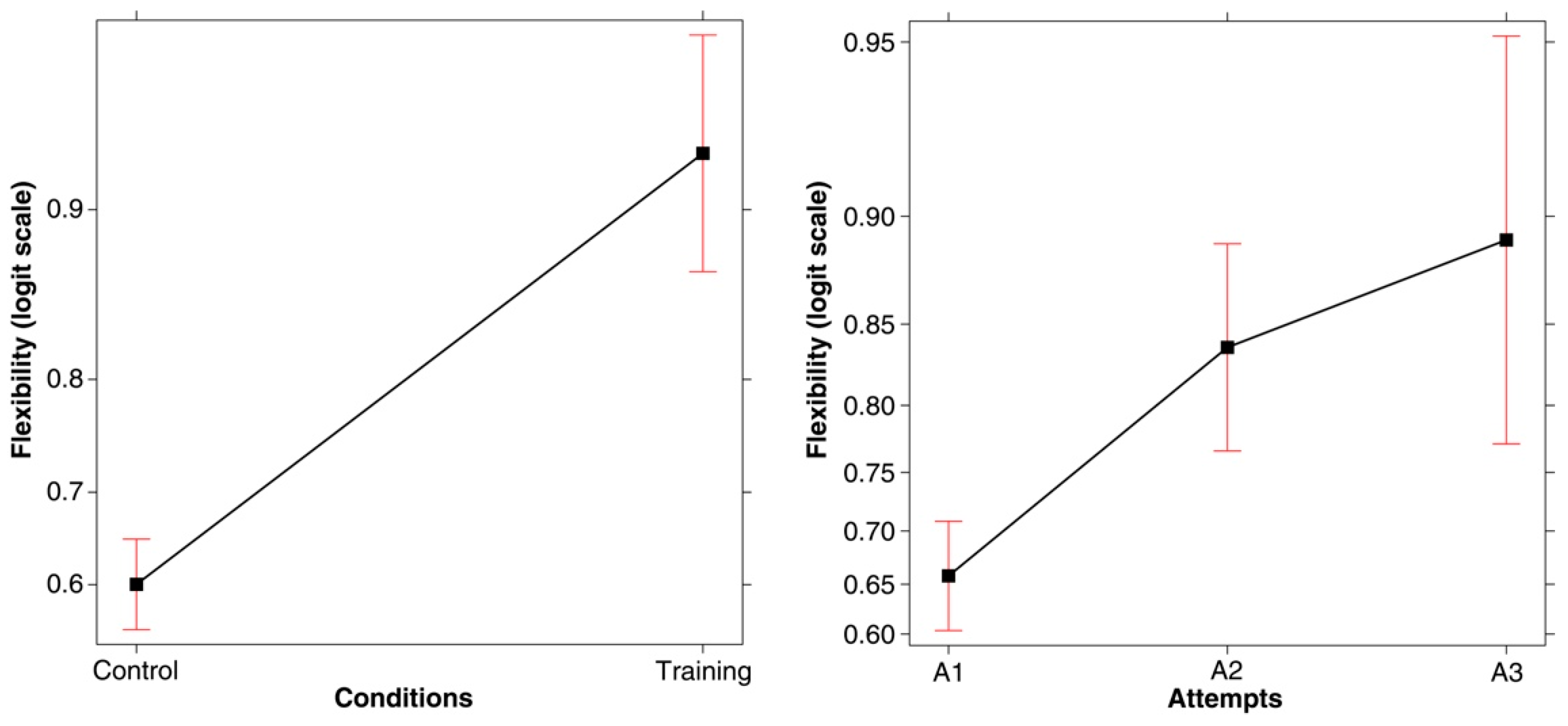
Disclaimer/Publisher’s Note: The statements, opinions and data contained in all publications are solely those of the individual author(s) and contributor(s) and not of MDPI and/or the editor(s). MDPI and/or the editor(s) disclaim responsibility for any injury to people or property resulting from any ideas, methods, instructions or products referred to in the content. |
© 2023 by the authors. Licensee MDPI, Basel, Switzerland. This article is an open access article distributed under the terms and conditions of the Creative Commons Attribution (CC BY) license (https://creativecommons.org/licenses/by/4.0/).
Share and Cite
Branchini, E.; Burro, R.; Bianchi, I. Training People to Think in Opposites Facilitates the Falsification Process in Wason’s Rule Discovery Task. J. Intell. 2023, 11, 91. https://doi.org/10.3390/jintelligence11050091
Branchini E, Burro R, Bianchi I. Training People to Think in Opposites Facilitates the Falsification Process in Wason’s Rule Discovery Task. Journal of Intelligence. 2023; 11(5):91. https://doi.org/10.3390/jintelligence11050091
Chicago/Turabian StyleBranchini, Erika, Roberto Burro, and Ivana Bianchi. 2023. "Training People to Think in Opposites Facilitates the Falsification Process in Wason’s Rule Discovery Task" Journal of Intelligence 11, no. 5: 91. https://doi.org/10.3390/jintelligence11050091
APA StyleBranchini, E., Burro, R., & Bianchi, I. (2023). Training People to Think in Opposites Facilitates the Falsification Process in Wason’s Rule Discovery Task. Journal of Intelligence, 11(5), 91. https://doi.org/10.3390/jintelligence11050091







